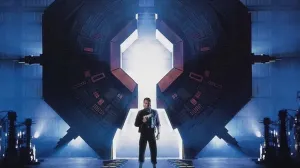People have a lot of opinions about SoulCalibur as a series. It’s funny, talking to people about their experience with these games yields very definite opinions about it being way more casual than Tekken, while others insist that it’s the most technically demanding 3D fighter ever made. Having spent considerable time playing competitive SoulCalibur IV, where memorizing frames and spending countless hours ingraining certain combo strings into your muscle memory were ways of life, I have to say that SoulCalibur VI offers a much more accessible ring for newcomers to step into.
Videos by ComicBook.com
The reversal edge mechanic, new to SoulCalibur VI, ensures that everyone has an opportunity to turn the tide of battle in their favor when their back is against the wall. By tapping or holding the right bumper or shoulder button, players can charge a blow-absorbing counter strike, which initiates a slow-motion game of chance. When a reversal edge is triggered by either player, both players will choose to unleash a horizontal blow, vertical blow, or kick, which all defeat or yield to each other paper-rock-scissors style. It’s very similar to the clash system we saw in Injustice 2; while it doesn’t ensure a victory, it can lead to some major shifts in fortune.
You can also use your reversal edge opportunity to dodge, and it’s worth nothing that this isn’t something you’ll want to spam just because you’re new. At first glance, I’m sure that some veteran players will roll their eyes and lament the fact that noobs are going to spam this counter online and launch into endless games of chance. This is not the case, as initiating a reversal edge at the wrong time can leave you incredibly vulnerable. Reversal edge strikes can be side-stepped with relative ease, and if they’re not fully charged, they can easily be blocked. You’ll want to think of this like guard impact or parry at higher levels of gameplay.
That said, the reversal edge does encourage a really great momentum, and it breathes some cinematic life into every single match. It’s not uncommon to see at least two or three reversal edge encounters play out in each round, and every single time, they look so damn cool. There’s nothing like seeing Nightmare’s enormous Soul-Edge crash down toward you in slow motion as you twist in mid-air and deliver a side-cracking kick. What’s more, when players choose the same option, they’ll clash and blow each other back before coming back for an additional duel. After two identical inputs from both players, the reversal edge will cancel out.
I spent almost an entire afternoon playing SoulCalibur VI with all six playable characters Bandai Namco made available for us. I played a variety of opponents, from experience Bandai Namco employees, to total newcomers. Across the board, even with the noobs, I found that the reversal edge mechanic encouarged every to play a little more aggressively. Stepping within sword’s-length of your opponent is a little easier to do when you know that you can attempt to trigger a cinematic and life-saving counter at any moment. It’s even more thrilling, in a way, knowing that it’s not a guaranteed free pass. There’s always a bit of risk involved, but because it looks so damn cool, the risk always seems like one worth taking.
I can’t wait for more of you to get your hands on this. SoulCalibur VI is being compared to the second game in the series for all of the right reasons. The (much) higher speed of play, simplified inputs for many signature moves, and cinematic turns of tide thanks to the reversal edge all come together to make something truly novel, and deeply gratifying.
Our soul still burns. We’ll have more on SoulCalibur VI soon, so stay tuned!








